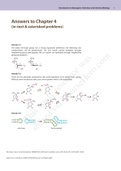All 2 results
Sort by
Newest Introduction to Bioorganic Chemistry and Chemical Biology summaries

-
Introduction to Bioorganic Chemistry and Chemical Biology: Chapter 4 Answers
- Exam (elaborations) • 7 pages • 2021
-
- $12.49
- + learn more
Answer 4.1 The bulky tert-butyl group has a strong equatorial preference, the following two conformations will be predominant. The anti isomer cannot hydrolyze through neighboring group participation; the syn isomer can hydrolyze through neighboring group participation. OCH3 -O P O O :O- anti Introduction to Bioorganic Chemistry and Chemical Biology | A4096 OCH3 -O P O O.. -O Van Vranken & Weiss | 978-0-8153-4214-4 Answer 4.2 There are two plausible mechanisms that av...

-
Introduction to Bioorganic Chemistry and Chemical Biology: Chapter 7 answers
- Exam (elaborations) • 6 pages • 2021
-
- $12.49
- + learn more
Answer 7.4 Compounds with the strongest axial donor lone pair would exhibit the strongest preference for an axial or Group Answer 7.5 In lubiprostone, the CF2 group should favor the cyclic hemiketal relative to the parent compound with CH2 Answer 7.6 the trend of faster hydrolysis of α-glucopyranosides holds for a wide range of glycosidic derivatives. Oddly, methyl α-d-glycosides (such as gluco, galacto, and xylo) hydrolyze more slowly than the corresponding β-anomers. © design by t...

Did you know that on average a seller on Stuvia earns $82 per month selling study resources? Hmm, hint, hint. Discover all about earning on Stuvia
